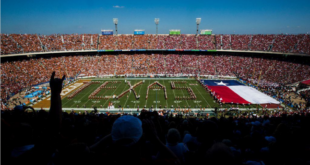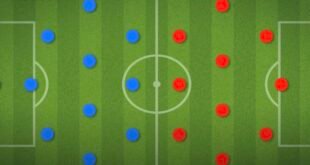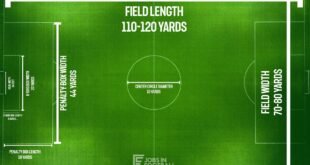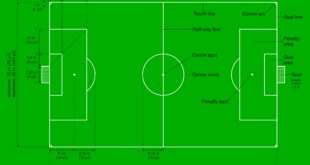A soccer field diagram illustrates the markings, dimensions, and layout of a soccer pitch. It typically includes the goal box, penalty area, center circle, and corner arcs.
Understanding a soccer field diagram is crucial for players, coaches, and fans alike. It serves as a blueprint for the game, outlining the areas where players can operate and the boundaries of play. This standardized format helps in strategizing game plans and in grasping the rules of the sport.
Soccer fields vary in size for different levels of play, from youth leagues to professional matches, but they maintain a set of key features defined by the sport’s governing bodies. The markings on the pitch are not merely decorative but provide essential guidelines for various aspects of the game, such as offsides, goal kicks, and corner kicks. Whether you are a newcomer to the sport or a seasoned veteran, familiarizing yourself with the soccer field layout enhances your understanding and appreciation of the game.
Soccer Field Diagram
Table of Contents
The Anatomy Of A Soccer Field
Understanding the anatomy of a soccer field is crucial for players, coaches, and fans alike. Beneath the lines and the goals lies a structure designed for the beautiful game. From a bird’s-eye view, this sprawling canvas is more than just grass and paint; It’s a stage set for athleticism, strategy, and skill where each element plays its part in the sport.
Key Measurements And Dimensions
A soccer field, also known as a pitch, varies in size. Rules state that its length should be between 100 and 130 yards and its width between 50 and 100 yards. These dimensions bring life to the game.
Here are some important parts with their standard sizes:
- Goal Area: 6 yards from each goalpost
- Penalty Area: 18 yards from each goalpost
- Center Circle: Radius of 10 yards
- Goal: 8 feet high and 8 yards wide
These markers ensure a fair and regulated playing field for all teams worldwide.
Grass Types And Surface Varieties
Across different climates and regions, grass types can vary immensely. Each type has unique characteristics.
Popular grass types include:
- Bermuda Grass: Perfect for warm climates
- Kentucky Bluegrass: Thrives in cooler areas
- Tall Fescue: Resistant to foot traffic
Artificial turfs are also common. They provide a consistent playing surface.

Lines And Markings
Understanding soccer’s lines and markings is crucial for grasping the game’s rules.
Knowing what each line represents helps players and fans alike follow the action on the pitch.
This visual guide will explore the key lines and markings of a soccer field.
Each plays a unique role during a match.
Sidelines And Endlines
Surrounding the soccer field are the sidelines and end lines.
These lines denote the outer boundaries.
The long boundary lines running the length of the field are the sidelines.
They signal the side limits of the playing area.
The shorter boundary lines are the end lines or goal lines.
They mark where the field ends and the goal begins.
The Center Circle And Halfway Line
At the midfield, the center circle and halfway line stand prominent.
The halfway line cuts the field into two halves.
The center circle holds a radius of 9.15 meters, important for kick-offs.
Players must stay outside this circle during a kick-off until the ball is in play.
The Penalty Area And Its Significance
The penalty area is critical in soccer.
It’s a rectangular box outside each goal.
Measures 18 yards deep and 44 yards wide.
Within this area, the goalkeeper can use their hands to touch the ball.
Fouls committed here can lead to penalty kicks and high-stakes moments in any game.
Goals: Positions And Specifications
Soccer isn’t just a game of skill and tactics; it’s also about the precise field setup. Central to this are the goals—one on each end of the pitch. They are where all the scoring action happens. To fully understand the game, we need to dive into the specifics of soccer goals, from their structure to safety measures.
Size And Structure
The size and structure of soccer goals are crucial for standard play. Professionals and beginners use goals of different sizes based on age and league rules. Let’s check the official sizes:
- Adults: 8 feet high and 24 feet wide.
- Juniors: Smaller in dimensions, often 7 feet high and 21 feet wide.
The structure is simple yet sturdy, typically made of metal or plastic. A crossbar connects two vertical posts, standing firm against powerful shots.
Netting Materials And Safety
The netting of a soccer goal is more than just a backdrop for a thrilling goal. The right material makes sure the ball stops after crossing the goal line. Common materials include:
- Polyethylene: Durable and weather-resistant.
- Nylon: High tensile strength for enduring impact.
- Polypropylene: Less stretch, maintains shape.
Safety is a top priority during gameplay. Goals must be anchored securely to prevent tipping. Regular checks ensure there are no risks to players, especially children. Soft caps should cover any sharp edges to prevent injuries during collisions.

The Corner Arc
The corner arc is crucial in soccer. It marks where corner kicks take place. The small quarter-circle with a radius of 1 yard sits snugly in the corners of the field.
Importance In-Play
Goals often stem from corners. The arc ensures fair play. It shows where the ball should be for a corner kick. Players must also stay clear of this zone, maintaining the required distance until the ball is in play.
Setting Up For The Corner Kick
- Place the ball so that it touches the corner arc line.
- Ensure all players are at least 10 yards away from the corner arc.
- Aim for teammates strategically positioned in the penalty area.
Technical Areas And Team Benches
Each soccer field comes with unique sections apart from the play area. Among these, the Technical Areas and Team Benches stand out. These areas host the strategy and support players rely on during the game. They are crucial for team dynamics and organization. Let’s explore these zones on the soccer field.
Coaches’ Zone
The Coaches’ Zone is a special spot on the sideline. In this zone, coaches command the game. They are close to the action but off the playing area. The rules of soccer specify how this zone is used:
- Coaches must stay within this zone.
- They guide their team from here.
- Players listen and watch for signals.
Substitute Management
Substitute Management happens near the team benches. This is where the team lists substitutes. Here is what happens in this area:
- Coaches choose which player comes on.
- Substitutes warm up nearby.
- Officials check substitutes before they play.
These zones make sure the game runs smoothly and fairly. They help coaches and subs to do their jobs well.

Soccer Equipment On The Field
Soccer, a game of skill and strategy, unfolds on a lush green field. An array of equipment dots this stage of play. Let’s explore the essentials that make a match possible, from the ball at the heart of the game to the flags that line the pitch.
Balls And Standards
The ball takes center stage in soccer. It must meet specific sizes and weights:
- Size 5 for adults – 68 to 70 cm in circumference
- Size 4 for youth – 63.5 to 66 cm in circumference
- Size 3 for children – 58.5 to 61 cm in circumference
Balls should bounce 55 to 65 cm when dropped from 1.5 m, establishing a standard for fairness and playability.
Flags And Match Officials’ Gear
Corner flags mark the pitch’s boundaries. They must be at least 1.5 meters high for visibility. Alongside them, the officials’ gear keeps the game in check. This gear includes:
| Equipment | Usage |
|---|---|
| Whistles | For starting and stopping the game |
| Watches | To track the match duration |
| Yellow and Red Cards | For player discipline |
| Flag | For signaling offside and other infractions |
Match officials also wear distinctive uniforms for easy identification on the field.
Maintenance And Field Upkeep
Behind every great soccer match is a well-maintained field. Consistent maintenance and field upkeep are essential. They ensure the pitch is safe and playable. From mowing the grass to marking lines clearly, every detail counts. Effective maintenance can prevent injuries and enhance the playing experience.
Daily And Seasonal Care
The quality of a soccer field reflects its daily and seasonal care routine. Here are key tasks that keep the field in top shape:
- Regular inspection for holes or damage.
- Grass cutting to the ideal height.
- Cleaning and checking goalposts and nets.
- Litter removal to keep the area clean.
- Seasonal aeration to promote healthy turf roots.
- Fertilization and weed control tailored to the climate.
Irrigation And Drainage Systems
Proper water management is a game-changer for soccer fields. Consider these points:
- A well-designed irrigation system saves water and keeps grass thriving.
- Drainage systems prevent waterlogging and turf diseases.
- Regular checks ensure systems work properly all year round.
| Day | Task |
|---|---|
| Monday | Inspect sprinkler heads and valves |
| Wednesday | Check soil moisture levels |
| Friday | Clear drainage outlets of debris |
Hosting Different Types Of Soccer Matches
Welcome to the dynamic world of soccer, where each game unfolds on a meticulously outlined field. A soccer field diagram serves as a strategic map, guiding players and fans alike. But did you know that hosting different types of soccer matches might require unique field modifications? Let’s delve into how various matches demand specific field adjustments.
Adjusting For Various Age Groups
To cater to the energetic strides of younger players, soccer fields can adapt in size. This ensures a fair and enjoyable game for all age groups. Below is a breakdown of how field dimensions adjust with age:
| Age Group | Field Size | Goal Size |
|---|---|---|
| Under 6 | 15-20 x 25-35 yards | 3 x 5 feet |
| Under 8 | 20-25 x 35-45 yards | 4 x 6 feet |
| Under 10 | 25-30 x 45-55 yards | 6 x 18 feet |
| Under 12 | 30-35 x 55-65 yards | 6 x 18 feet |
| Under 14 | 35-40 x 65-75 yards | 7 x 21 feet |
These dimensions ensure that players have the space to develop their skills without feeling overwhelmed by an adult-sized pitch.
International Matches And Regulations
For an international match, FIFA sets strict regulations. The soccer field must meet precise dimensions:
- Length: 100 to 110 meters (110 to 120 yards)
- Width: 64 to 75 meters (70 to 80 yards)
Pitch markings, goal sizes, and even the quality of the turf must comply with rigorous standards. FIFA’s “Laws of the Game” dictate these rules, keeping the field consistent for every elite match. The requirements ensure fair play and world-class competition.
Frequently Asked Questions on Soccer Field Diagram
What are the dimensions of a soccer field?
Soccer fields vary in size. A professional field is typically 100 to 130 yards long and 50 to 100 yards wide. These dimensions can change slightly based on the rules of specific leagues or associations overseeing the games.
What lines are marked on a soccer field diagram?
A soccer field diagram displays the perimeter, halfway line, center circle, goal boxes, penalty areas, corners, and the penalty spot. These markings are essential for gameplay, guiding players and referees alike during a match.
Where are the goals placed on a soccer field?
Goals are positioned centrally on the end lines of a soccer field. The inner edges of the vertical goal posts are 8 yards apart, with a crossbar connecting them 8 feet above the ground. These dimensions are consistent across professional levels.
How is the penalty area marked on a soccer field?
The penalty area is a rectangular box extending 18 yards from each goal post and 18 yards into the field. It includes the penalty spot, located 12 yards from the goal line, and the arc of the penalty area, known as the “D.
Conclusion
As we wrap up our exploration of the soccer field diagram, remember the key components that dictate the flow of the game. Familiarize yourself with each marked area to fully appreciate the sport’s intricacies. Mastery of this groundwork not only enhances a player’s strategic approach but also enriches the spectator’s experience.
 Cric Enjoy Sports News, Cricket Update, Live Streaming
Cric Enjoy Sports News, Cricket Update, Live Streaming






